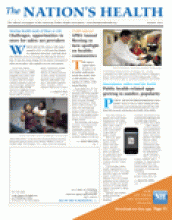When health reform is fully implemented in 2014, it will mean big changes for uninsured Americans, especially those who will have access to coverage for what may be the first time. It may also mean changes for the nation’s thousands of safety net providers, who regularly care for such patients.
Across the nation, providers such as community health centers, public hospitals, free clinics and health departments serve as safety nets for people without insurance, providing screenings, immunizations and other health services to millions of people who might otherwise not be able to receive them. Community health centers alone treated almost 20 million patients in 2010, about 40 percent of whom were uninsured. With the Affordable Care Act’s “individual responsibility” mandate, which requires Americans to have at least basic health insurance, scheduled to take effect in 2014, health leaders have been speculating how the role of such providers might change.

Alma Delia Torres, 8, has her ears checked by Reyna Martinez during her physical exam at the Horton Wellness Center in October 2010. The Durham, N.C., clinic serves the uninsured.
Photo by Jason Arthurs, courtesy The Washington Post/Getty Images
“There’s the misperception that the programs won’t be needed, and there’s also the misperception of who will seek services from the programs,” Stacey Chazin, MPH, program officer for the Center for Health Care Strategies, told The Nation’s Health. “There is still going to be a sizeable number of folks who simply will not be able to afford any of the coverage options.”
In August, a survey from the Commonwealth Fund found 98 percent of health and health care policy leaders believe safety net providers will be crucial even after health reform is fully implemented. According to the survey, such providers are best-equipped to meet the needs of vulnerable populations, not all of whom will have insurance, despite the mandate.
More than 20 million people, about one-third of them illegal immigrants, will remain uninsured even after all reforms take effect, according to Pamela Riley, MD, MPH, program officer for vulnerable populations for the Commonwealth Fund. Other people who remain uninsured may include those who opt to pay a fine rather than purchase insurance.
Riley called health reform “overall, an opportunity” for safety net providers.
“Given the changes coming down the pike, it will sort of be a motivator for people to share resources to see how they can work together to take advantage of the provisions of health reform,” Riley told The Nation’s Health.
One of the key issues for safety net providers as reform is implemented is preparing for a surge in newly insured patients who need more care because they are entering the system for the first time, according to APHA member Sara Rosenbaum, JD, a health law professor at George Washington University.
Also, providers must prepare to provide outreach to enroll those newly eligible for coverage, she said.
“Everybody has challenges under health reform,” Rosenbaum told The Nation’s Health. “The nice thing about safety net providers is that I think they are very accustomed to challenges. This is their calling card. This is what they have been used to. They are not hothouse flowers. They are real distance runners.”
Health leaders looking for insights into the future of the nation’s safety net providers need look no further than Massachusetts, which enacted state-level health reform in 2006, decreasing its uninsured population to 3 percent. Between 2005 and 2009, the number of overall patients treated at community health centers rose 31 percent in Massachusetts, according to a study in the August issue of Archives of Internal Medicine. At the same time, the proportion of uninsured patients visiting Massachusetts community health centers dropped from almost 36 percent to about 20 percent.

Carmen Landaverde and her daughter Jocelyn, 16 months, check in at the Lynn, Mass., Community Health Center in March. The number of visits to Massachusetts community health centers increased after reform took effect in the state.
Photo by Wendy Maeda, courtesy The Boston Globe/Getty Images
“When people had insurance, the demand for care went up,” said Leighton Ku, PhD, the study’s lead author and a professor of health policy and director of the Center for Health Policy Research at George Washington University.
The study also found ambulatory care at safety net hospitals rose 9 percent, compared to a 4 percent growth at other hospitals. When patients were surveyed, three-quarters said they preferred safety net providers as a source of care.
“I think many people assume that safety net providers sort of offer second-class health care and the only reason people go there is because they’re poor or they’re desperate,” said Ku, who is an APHA member. “What we saw from the study was that even when people had insurance cards, they continued to seek care from safety net providers.”
Beyond Massachusetts, safety net providers are aware that changes are coming and are preparing by linking together in new networks and examining their ability to provide outreach.
One such group of providers is the Western Carolina Medical Society in North Carolina, an association of about 900 physicians. The society has a safety net system called Project Access that centers on office-based charity care, with a local hospital offering free laboratory services, hospitalization and imaging services.
With reforms on the horizon, the society is exploring new collaborations, including a plan to partner more closely with a network of primary care physicians known as Community Care of North Carolina, which has a proven track record of saving the state millions of dollars in Medicaid costs by managing the care of chronically ill patients. Other plans include reaching out to specialty physician practices to return some patients to primary care, if appropriate, and a partnership to help physicians adopt electronic medical records.
While society providers believe a large portion of their current patient load will be covered under Medicaid in 2014, safety net providers will be playing a role in making that happen, according to Miriam Schwarz, CEO and executive director of the Western Carolina Medical Society.
“We’re also going to have to be responsible for ensuring a smooth transition of uninsured patients to Medicaid,” Schwarz told The Nation’s Health. “We have to be very diligent about catching those folks and making sure that they are appropriately covered.”
Though health reform presents some challenges, Schwarz is one of many health leaders stressing the positive side of change.
“We’re seeing an opportunity to recalibrate our safety net system and tighten up,” she said. “I think it’s energized the various parties around the table. There’s some outside-of-the-box thinking, which is very exciting. It gives us an opportunity to make improvements in some areas that we knew needed changing but we just didn’t have the platform to make those changes.”
Even as safety net providers make plans in advance of health reform, U.S. courts continue to address the legality of the health insurance mandate, with an appeals court again ruling it unconstitutional in August. The mandate has been both upheld and struck down in at least seven court cases since the Affordable Care Act was passed, and the ultimate decision may be made in the U.S. Supreme Court.
For more information on health reform, visit www.healthreform.gov. For the Commonwealth Fund report, visit www.commonwealthfund.org.
- Copyright The Nation’s Health, American Public Health Association









